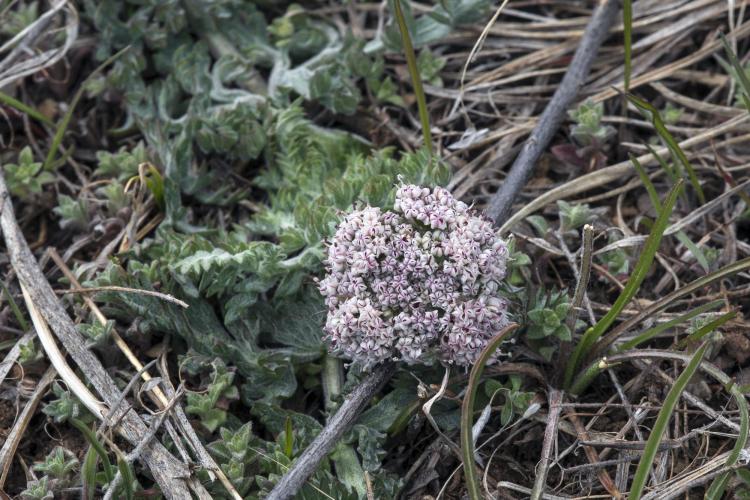Salt and pepper adds spice to spring
The flowers of salt and pepper are tiny and arranged into compound groups called umbels, or bouquets in the shape of an umbrella
In March and April of each year I get anxious for the arrival of spring. I watch the days get longer and visit a variety of sites in Colorado and on the Colorado Plateau to see what is up and blooming and who is pollinating. For two years in a row I have noticed white and red umbels of a small plant beside the High Plains Trail in our Open Space and Mountain Parks (OSMP). But I could not identify it, so I sent photos of it to local experts.
Lynn Riedel in OSMP and Tim Hogan in CU's Museum Herbarium both identified it as Lomatium orientale, one of the spring parsleys commonly called salt and pepper. A search for academic papers about this species revealed why I had trouble identifying it. Species in the genus Lomatium are difficult to identify because some of the species have substantial variation in color and morphology and also because this genus is very similar to the genus Cymopterus. Experts freely admit that the characters that supposedly distinguish Lomatium and Cymopterus completely fail to place some species in either genus. Both genera are in the family Apiaceae, the celery, carrot or parsley family, or simply umbellifers. Two genetic studies attempting to reconstruct the evolution of Apiaceae found phylogenetic trees with Lomatium and Cymopterus species intermixed in the various branches of the trees. A plausible evolutionary tree would present exclusively Lomatium species in one branch and exclusively Cymopterus species in a separate branch.

Salt and pepper is one of early blooming native wildflowers. Photo by Jeff Mitton.
Early systematists assigned species names by grouping species with similar morphologies, flower structures, and habitats--those were the sorts of data available to early systematists. But now that we can compare patterns of variation in the early characters with thousands of genetic markers, we can see that in some groups morphological characters were much more labile than imagined and cannot reliably reconstruct evolutionary history. Many of the names in Lomatium and Cymopterus need to be changed.
The flowers of salt and pepper are tiny and arranged into compound groups called umbels, or bouquets in the shape of an umbrella. Each umbel is composed of about a dozen smaller umbrellas called umbelets, each containing up to 30 tiny flowers. Most of the plants at the High Plains Trail had one, two or three umbels, but in other locations large plants may produce up to 15 umbels. So, a plant might have as few as 360 or as many as 5,400 flowers.
Each flower is about 1/8 inch in diameter with five white, pointed petals that are curved inward so their tips nearly meet. Pale stamens with bright red anthers protrude from the tiny spaces between the petals.
Leaves grow from the base of the plant and are about four inches long, each compounded three times, producing intricate, frilly shapes resembling fern leaves."
Leaves grow from the base of the plant and are about four inches long, each compounded three times, producing intricate, frilly shapes resembling fern leaves.
Few studies have focused on salt and pepper, but fernleaf biscuitroot, Lomatium dissectum, has been studied extensively in the laboratory of John Thompson, working at the Rocky Mountain Biological Laboratory in Gothic, CO. A decade long study of marked plants recorded how many herbivores and pathogens visited each plant each year. Each year, 68% of plants were attacked by at least one insect or pathogen, and by the end of the decade all surviving plants had been attacked by 2 to 5 enemies. Most of the plants died during the decade long experiment, and northern pocket gophers killed almost half of those that perished by eating their roots.
Native Americans have used various species of Lomatium for a variety of medicines, and indeed, concoctions made from various parts of the plant have antimicrobial, antiviral and antifungal activities. Lomatium secondary compounds repel many herbivores and pathogens, providing competitor-free resources for those species able to sequester, avoid, or dismantle the chemical compounds. The plant secondary compounds are also employed by butterflies and moths to find plants for oviposition and larval host feeding. For example, L. papilioniferum is a larval host plant for anise swallowtail (Papilio zelicaon) and indra swallowtail (P. indra) butterflies. Larvae of the moth Greya subalba feed on the seeds of L. dissectum, and in a study covering three years, moth larvae consumed between 10% and 65% from each of the plants. In the moth genus Depressaria about half of the species specialize on Lomatium species. One Depressaria species feeds exclusively on L. papilioniferum, and another feeds exclusively on fernleaf biscuitroot, L. dissectum.
I was not able to find anything about salt and pepper's chemical defenses or insects that use it. But given numerous reports of insects on Lomatium, I am now curious to know whether any of our local butterflies or moths use salt and pepper for oviposition and larval feeding. So, I will return to the High Plains Trail repeated this summer, looking for caterpillars.

